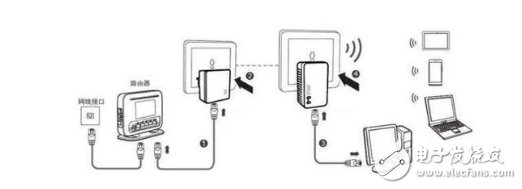Since United Technologies acquired the avionics and interiors business for $23 billion, it has become one of the world's leading suppliers of aviation components. To address the issue of limited charging stations in waiting areas, the airline implemented Qualcomm's dual-channel WiFi technology. This not only expands coverage but also significantly improves network capacity, ensuring that passengers can enjoy fast and stable WiFi even in the lounge, restroom, or retail area.
Many people may wonder—given the vast size of airports and the large number of connected devices—how is it possible to maintain such excellent WiFi coverage and speed? In contrast, home networks, which are much smaller, often suffer from poor signal strength. The answer lies in advanced technologies like MU-MIMO and AC+AP setups, which help manage traffic and optimize performance in high-density environments.
Struggling with weak home WiFi? This could be your solution
Modern airports typically use an AC+AP system, where a central wireless controller (AC) manages multiple access points (APs). While effective, this setup requires large, power-hungry equipment, making it unsuitable for typical home use. For residential settings, alternatives like mesh routers or powerline adapters are often used, but they come with their own limitations.

Using multiple routers for bridging can lead to slower speeds and unstable connections, while powerline adapters depend on the quality of your wiring. If the wires are old or damaged, these solutions may not work well at all. So, is there a better way to get full coverage without all the hassle?
Yes—Qualcomm’s dual-channel WiFi technology offers a one-step solution. With just one router, you can achieve strong, consistent coverage throughout your home, eliminating the need for complicated setups.

Before diving into how impressive dual-channel WiFi is, let’s break down what it really means. Traditional single-channel WiFi uses one antenna for both transmitting and receiving data, which can cause congestion when multiple devices are connected. Think of it as a single-lane road—when too many cars are on it, traffic jams are inevitable.
Dual-channel WiFi, also known as 2x2 MIMO, adds an extra channel, effectively doubling the bandwidth. It’s like having two lanes instead of one, allowing more data to travel simultaneously and reducing interference. This results in faster speeds and better coverage, even in hard-to-reach corners of your home.
In lab tests, Qualcomm’s dual-channel WiFi achieved up to twice the throughput of single-channel WiFi. With a router that supports this technology, you can enjoy smooth HD streaming, lag-free gaming, and fast downloads—even in the farthest parts of your house. Plus, it helps reduce device power consumption by up to 30%, extending your phone or tablet’s battery life.
After switching to Qualcomm’s dual-channel WiFi, your smartphone and tablet will last longer, and you’ll be able to stream HD videos in any room—no more buffering or dropped connections!
Several popular smartphones already support this technology, including the OPPO R11, vivo X20, Xiaomi 6, Xiaomi MIX2, and OnePlus 5. As more devices adopt Qualcomm’s dual-channel WiFi and the Snapdragon platform becomes more widespread, more users will experience the benefits of faster, more reliable connectivity in their homes.
Guangzhou Yunge Tianhong Electronic Technology Co., Ltd , http://www.e-cigaretteyfactory.com